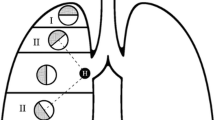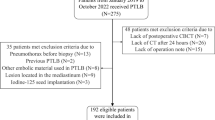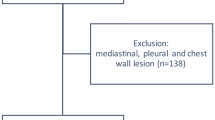Summary
The factors influencing the incidence of common complications (pneumothorax and pulmonary hemorrhage) of CT-guided percutaneous needle biopsy of lumps near pulmonary hilum were investigated. CT-guided percutaneous needle biopsy of lumps near pulmonary hilum was performed on 48 patients. The complications of pneumothorax and pneumorrhagia as well as the contributing factors were analyzed statistically. The major complications associated with CT-guided needle biopsy included pneumothorax (13 cases, 27.1%) and pulmonary hemorrhage (14 cases, 20.24%). χ2 test revealed that pneumothorax was associated with the lesion size and depth of needle penetration, and pulmonary hemorrhage with the depth of needle penetration and needle retention time with a significant P value. Pneumothorax was observed in 7 cases (17.5%) out of 40 cases with diameter of mass greater than 3 cm, and in 6 cases (60%) out of 10 cases with depth of needle penetration greater than 4 cm. Additionally, pulmonary hemorrhage was identified in 12 cases (41.4%) out of 29 cases with needle retention time longer than 15 min, and pulmonary hemorrhage in 7 cases (70%) out of 10 cases with depth of needle penetration greater than 4 cm. CT-guided percutaneous needle biopsy of lumps near pulmonary hilum is safe and effective. The key factors to prevent the complications include correct evaluation of lesion size, depth of needle penetration and the needle retention time before the operation.
Similar content being viewed by others
References
Jemal A, Bray F, Center MM, et al. Global cancer statistics. CA Cancer J Clin, 2011,61(2):69–90
Westcott JL. Percutaneous transthoracic needle biopsy. Radiology, 1988,169(3):593–601
Paez JG, Jänne PA, Lee JC, et al. EGFR mutations in lung cancer: correlation with clinical response to geitinib therapy. Science, 2004,304(5676):1497–1500
Chen CM, Chang JW, Cheung YC, et al. Computed tomography- guided core-needle biopsy specimens show epidermal growth factor receptor mutations in patients with non-small-cell lung cancer. Acta Radiol, 2008,49(9):991–994
Bunyaviroch T, Coleman RE. PET evaluation of lung cancer. J Nucl Med, 2006,47(3):451–469
Charig MJ, Phillips AJ. CT-guided cutting needle biopsy of lung lesions: safety and efficacy of an outpatient service. Clin Radiol, 2000,55(12):964–969
Steil S, Zerwas S, Moos G, et al. CT-guided percutaneous core needle biopsy in oncology outpatients: sensitivity, specificity, complications. Onkologie, 2009,32(5):254–258
Klein JS, Salomon G, Stewart EA. Transthoracic needle biopsy with a coaxially placed 20-gauge automated cutting needle: results in 122 patients. Radiology, 1996,198(3): 715–720
Yeow KM, Su IH, Pan KT, et al. Risk factors of pneumothorax and bleeding: multivariate analysis of 660 CT-guided coaxial cutting needle lung biopsies. Chest, 2004,126(3):748–754
Covey AM, Gandhi R, Brody LA, et al. Factors associated with pneumothorax and pneumothorax requiring treatment after percutaneous lung biopsy in 443 consecutive patients. J Vasc Interv Radiol, 2004,15(5):479–483
Saji H, Nakamura H, Tsuchida T, et al. The incidence and the risk of pneumothorax and chesttube placement after percutaneous CT-guided lung biopsy: the angle of the needle trajectory is a novel predictor. Chest, 2002,121(5):1521–1526
Yeow KM, Tsay PK, Cheung YC, et al. Factors affecting diagnostic accuracy of CT-guided coaxial cutting needle lung biopsy: retrospective analysis of 631 procedures. J Vasc Interv Radiol, 2003,14(5):581–588
Kazerooni EA, Lim FT, Mikhail A, et al. Risk of pneumothorax in CT-guided transthoracic needle aspiration biopsy of the lung. Radiology, 1996,198(2):371–375
Cox JE, Chiles C, McManus CM, et al. Transthoracic needle aspiration biopsy: variables that affect risk of pneumothorax. Radiology, 1999,212(1):165–168
Laurent F, Michel P, Latrabe V, et al. Pneumothorax and chest tube placement after CT-guided transthoracic lung biopsy using a coaxial technique: incidence and risk factors. Am J Roentgenol, 1999,172(4):1049–1053
Kazerooni EA, Hartker FW, Whyte RI, et al. Transthoracic needle aspiration in patients with severe emphysema: a study of lung transplant candidates. Chest, 1996,109(3): 616–620
Vallop L, Chalida A, Kobkul S. Adequacy and complications of CT-guided percutaneous biopsy: a study of 334 cases in Srinagarind hospital. J Med Assoc Thai, 2009,92(7):939–946
Biswajit Ch, John E. E, Rakesh P, et al. Risk assessment of pneumothorax and pulmonary haemorrhage complicating percutaneous co-axial cutting needle lung biopsy. Respir Med, 2009,103(3):449–455
Richardson CM, Pointon KS, Manhire AR, et al. Percutaneous lung biopsies: a survey of UK practice based on 5444 biopsies. Br J Radiol, 2002,75(897):731–735
Manhire A, Charig M, Clelland C, et al. Guidelines for radiologically guided lung biopsy. Thorax, 2003,58(11):920–936
Choo JY, Park CM, Lee NK, et al. Percutaneous transthoracic needle biopsy of small (≤ 1 cm) lung nodules under C-arm cone-beam CT virtual navigation guidance. Eur Radiol, 2013,23(3):712–719
Lee SM, Park CM, Lee KH, et al. C-arm cone-beam CT-guided percutaneous transthoracic needle biopsy of lung nodules: clinical experience in 1108 patients. Radiology, 2014,271(1):291–300
Yankelevitz DF, Vazquez M, Henschke CI. Special techniques in transthoracic needle biopsy of pulmonary nodules. Radiol Clin North Am, 2000,38(2):267–279
Author information
Authors and Affiliations
Corresponding author
Additional information
This project was supported by the National Natural Science Foundation of China (No. 81102074).
Rights and permissions
About this article
Cite this article
Yin, Zy., Lin, Zy., Wang, Y. et al. Risk factors of complications after CT-guided percutaneous needle biopsy of lumps near pulmonary hilum. J. Huazhong Univ. Sci. Technol. [Med. Sci.] 35, 278–282 (2015). https://doi.org/10.1007/s11596-015-1424-3
Received:
Revised:
Published:
Issue Date:
DOI: https://doi.org/10.1007/s11596-015-1424-3




